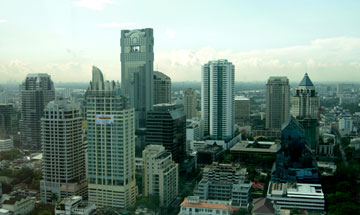Global automobile manufacturing is ever more about managing suppliers.
From Paul A. Renaud. www.thaistocks.com March 10, 200. Released to all viewers on April 6th '07
The "global plant floor for automobiles" -and why SAT (and TSC) should benefit handsomely from this trend in years to come.
In an excellent newer book called Wikinomics, by Don Tapscott and Anthony D. Williams, the authors get into the supreme timely subject of how internet enabled mass collaboration, changes everything. (The Publisher is the Penguin Group, 2006).
The old hardwired "plan and push" mentality, is rapidly giving way to the new dynamic of an engage and then co-create economy. The book writes at length about the four new mantras: openness, peering, sharing and acting globally…as they say: "the winning organizations (and societies) will be those that tap the torrent of human knowledge and translate it into new and useful applications". It is a book which has given me many new insights, some of which I will come back in future writings.
I read dozens of non-fiction books every year, and probably spend more money and time on reading then on costs of hosting and engaging in this website. I find much reading (beyond newspapers and magazines) enhances deeper understanding at all levels and so helps in investor success.
Today I wish to share one such understanding with you which got me ever more excited about the new stock choice Somboon Group, SAT (10.10). Let SAT (10.10) so be my single big call for you this year, it is yet to be seen how visionary this will turn out to be. Members realize that since mid February I have increasingly warmed up to SAT (at the time priced at 9.50 -and now 10.10), a company I visited in person in mid February and promptly wrote it up rather favorably.
The stock price has since increased some 6%, even while the SET index dropped some 4% during this same time, a so not to be unnoticed 10% divergence. I expressed here long ago that the SET is much a market of stocks more then a stock market -and I believe this divergence with SAT will continue, i.e. SAT should continue to outperform the SET index, perhaps significantly so this year and next. I think SAT's stock price could easily double within say the next 12-18 months and it so has a prominent standing in my chosen picks going into year 2007. I remain convinced that this month a major announcement is coming regarding a new added value car product/component which SAT will produce for a major Japanese customer.
Today I want to review some macro reasons why SAT's industry is a prominent and likely fast growing one, and yet how many still don't understand why this is. In the above mentioned book there is an excellent chapter starting on page 213 called "The Global Plant Floor". IF you have a chance to read only this chapter, by all means do so, but forewarned that if get to this, you will probably right away invest more in SAT shares (and Thai Steel & Cable, TSC my second choice -and Ticon, which are both my secondary picks for this expanding sector). I will try to here summarize for you why this is so.
Ticon (16.9) of course indirectly so will also benefit from this understanding as it is part of this as new outsourcing boom reality as well. Yet, SAT now is my top pick. This excellent book throughout argues well that the old monolithic multinational which creates value in a closed hierarchical fashion is dead. The point is that outsourcing as we know it is way understated and far from saturated!
In fact, just the opposite is so. Increasingly so manufacturers (and especially automobile manufacturers) are sourcing ever more of their parts around the globe while producing less and less themselves. It is not just a way to off-load costs, no outsourcing is increasingly a way to gain speed, innovation besides knowledge. The new motto is "Strive to be the best of what your customers value most -and partner for everything else". I think the new buzzword for all this is modular manufacturing (or localized modularization) and it’s a big subject which we will hear more and more going forward. Consider that a growing number of car companies are no longer really manufacturing cars. They are ever more just marketing companies which manage their suppliers besides their brands, establish dealerships and provide warranty service.
Here is just one example: "BMW focuses on marketing, partnering and customer relationships, and it maintains the engineering expertise it deems critical, but suppliers make most of the components and increasingly these (suppliers) assemble the final vehicle….it turns out that a company like Magna International can assemble a vehicle faster, cheaper and with better quality than BMW." According to this book, some 70% of the BMW 7 series was designed, built and assembled not by BMW but by a worldwide network of suppliers. What's more, is that it is estimated that by year 2015, the suppliers not the automakers, will conduct most of the R&D and production. It will be called the global plant floor for automobiles.
Suppliers already develop and build some 65% of the average motor vehicle and "this percentage is bound to increase to 80% in the coming decades, making suppliers the main engine of growth and jobs in this industry". Clearly automakers and suppliers will be closer and more intertwined than ever before. Developing new ways to harness talent outside their boundaries remains an important and largely unexplored frontier in the auto industry. This is now changing in a major way.
A significant and ever increasing amount of responsibility for innovation (not to mention outsourcing) is handed over to many different suppliers and this is enabling a big change on how car companies compete around the globe. For global car companies, its less and less about building and manufacturing and more and more about orchestrating, managing and finding new suppliers and then coordinating good ideas among these. As they explain further: "managing an increasingly seamless and supple fusion of design and development expertise from multiple suppliers, partners and customers in global design and process collaborations".
This is the way forward and at an ever increasing speed, as "peer collaboration and production can give rise to potent competitive advantages, even in manufacturing industries where precision, efficiency and quality control are mission critical". Deepening supplier involvement has significantly boosted the efficiency of the design process. This way manufacturers get ideas from everybody out there, not just their own engineers. This trend is already prominent in the aviation industry (Boeing's new Dream liner 787 and the Airbus) and has been a key reasons why the Chinese took over and now dominate an entire range of motorcycle production.
Global design and development teams and suppliers is increasingly so a baseline requirement, just to stay in business.  It’s the new mega trend here, and its big business and my call is SAT and TSC will much benefit from this global reality in automobile production. For now I wish to state again that I favor overweighing these new ideas with SAT being the biggest core holding, in my view, going forward. ***
It’s the new mega trend here, and its big business and my call is SAT and TSC will much benefit from this global reality in automobile production. For now I wish to state again that I favor overweighing these new ideas with SAT being the biggest core holding, in my view, going forward. ***
In the Bangkok Post of March 8th '07, (backside of the Business section), there is an article called "Small Business, productivity and competitiveness" in which it is predicted that "the automotive and parts industry would generate revenue of 83 billion Baht this year, expanding 28% on the previous year". By far the highest predicted growth sector of any SME operators there analysed. This as according to OSMEP, or the Office of Small and Medium Enterprises Promotion. http://cms.sme.go.th/cms/web/osmep (Thai language only). ***
Here are some additional comments I have, as we move into the final couple of weeks, of the first quarter 2007. ---Post stock markets sell off, which started in China, Thailand is now the best performing market in Asia for year 2007. Yet, Thai stocks in general are & remain among the cheapest in the world. ---Last year the Thai Baht currency appreciated some 17% vs. the US Dollar, as such the Baht was the strongest currency in Asia.
In 2007 the Baht currency shows continued firmness, despite the (now already watered down) capital controls introduced on Dec 19 '06. While the SET benchmark index dropped some 6% during year 2006, my own posted model portfolio at the web site increased 22.9% last year. And if I add the 17% increase in value of the Baht vs. US$ currency, in US$ we so got ahead by 40%. Always on a fully diversified stock portfolio basis of value shares -and assuming no margin leverage and no derivatives. Many managed portfolios use both margin leverage and/or derivatives, so its more risky. Some of these managers dare to state that no margin leverage is used, only the using of derivatives.
Yet this can be the same as margin leverage, as the true risks are often magnified when employing complicated derivative strategies. For years here I have been showing again and again, that if one gets beyond the top 50 stocks here, considerable outperformance is just about the norm, every time. At the below web link, You can see the broad performance as showed by market cap, vs by sector. And it assumes no stock picking; which is something I know we can excel here, as I regularly visit companies in person and have nearly 20 years "on location" professional experience.
http://www.thaistocks.com/modules.php?op=modload&name=News&file=index&ca... (If this link does not work, please just copy and past the whole link into your browser).
The point of it all is that for serious rational investors, a great deal of investment values are to be had in the secondary Thai shares; but you got to get beyond the "SET 50" -and be a longer term oriented investor, seeking high dividend yield besides earnings growth. All you members are to be congratulated in having seen the long term merits of this.
Best Regards,
Paul A. Renaud.
The quotes above are from the mentioned book: Wikinomics, by Don Tapscott and Anthony D. Williams.

